The cultural capital of the indigo-dyed textiles community of Phu Tai ethnic group for the development of creative tourism communities
This article aims to study the cultural capital of the indigo dyeing community
of Ban Nong Khrong, Don Kloy, Kham Kha and Oun Dong, Phannanikhom
District, Sakon Nakhon Province, Thailand. This is developed as a creative
cultural tourism village, obtained from the collected cultural capital data,
consisting of the social and cultural context of the indigo dyeing cloth
community through participation observation, in-depth interviews, group
discussions and experimentation with the key informants in order to find out
the ways for developing into a cultural community for sustainable tourism. The
study found that there was cultural capital in this community, characterized by
indigo dyed cotton weaving, which is a factor that affects the income of people
in the community. Most of the inhabitants in Ban Nong Khrong, Don Kloy,
Kham Kha and Oun Dong inherited this indigo cloth weaving and dying
wisdom from their ancestors. The study also attempts to create more value by
adding cultural capital and wisdom of Phu Tai ethnic identity and indigo dyed
textiles as a representation of cultural tourism community, by using the
community presentation model with creative tourism activities such as dyeing,
weaving and local cooking. These activities create a shared experience for
tourist’s participatory learning about the cultural capital and wisdom of the Phu
Tai community.
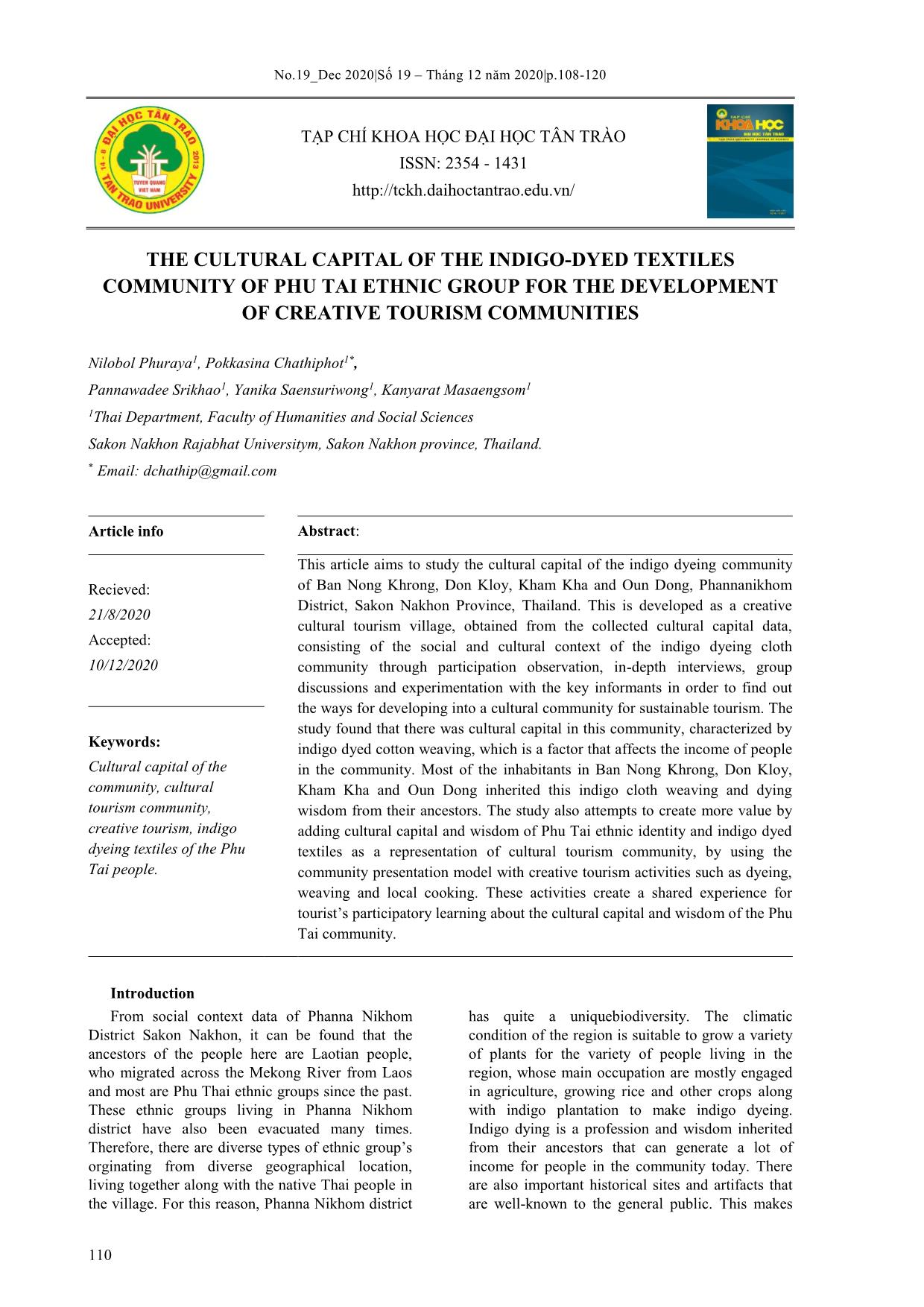
Trang 1
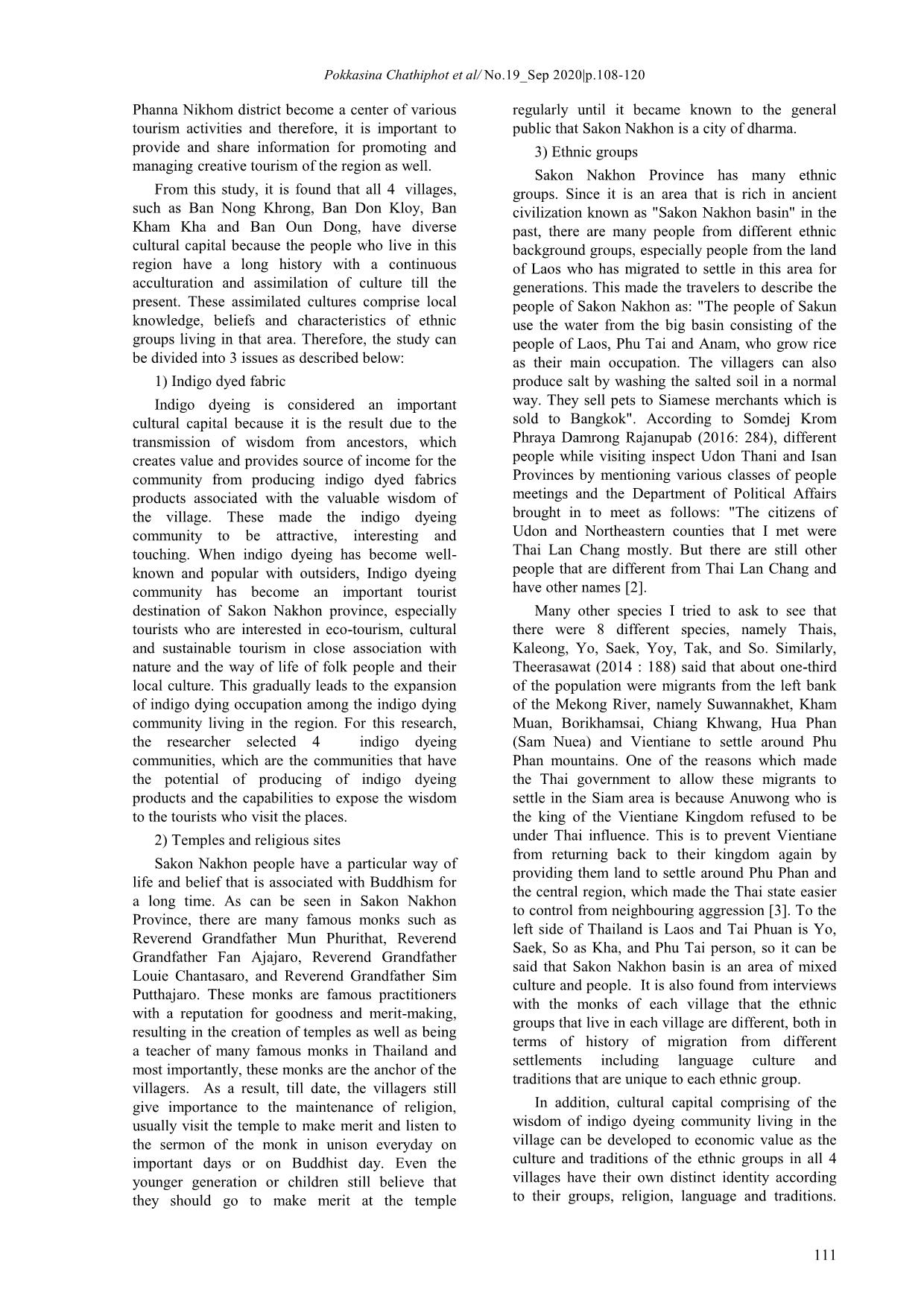
Trang 2
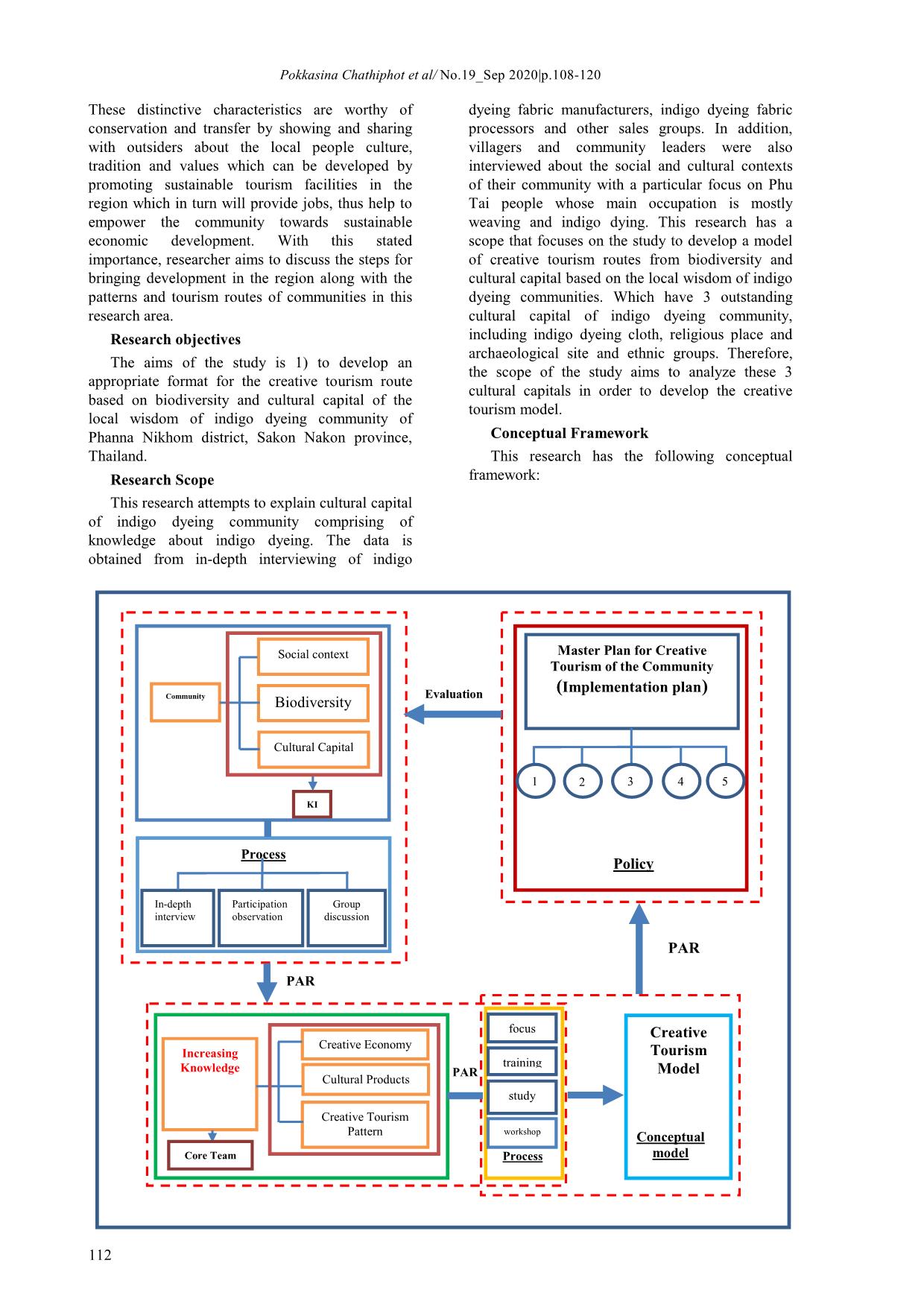
Trang 3
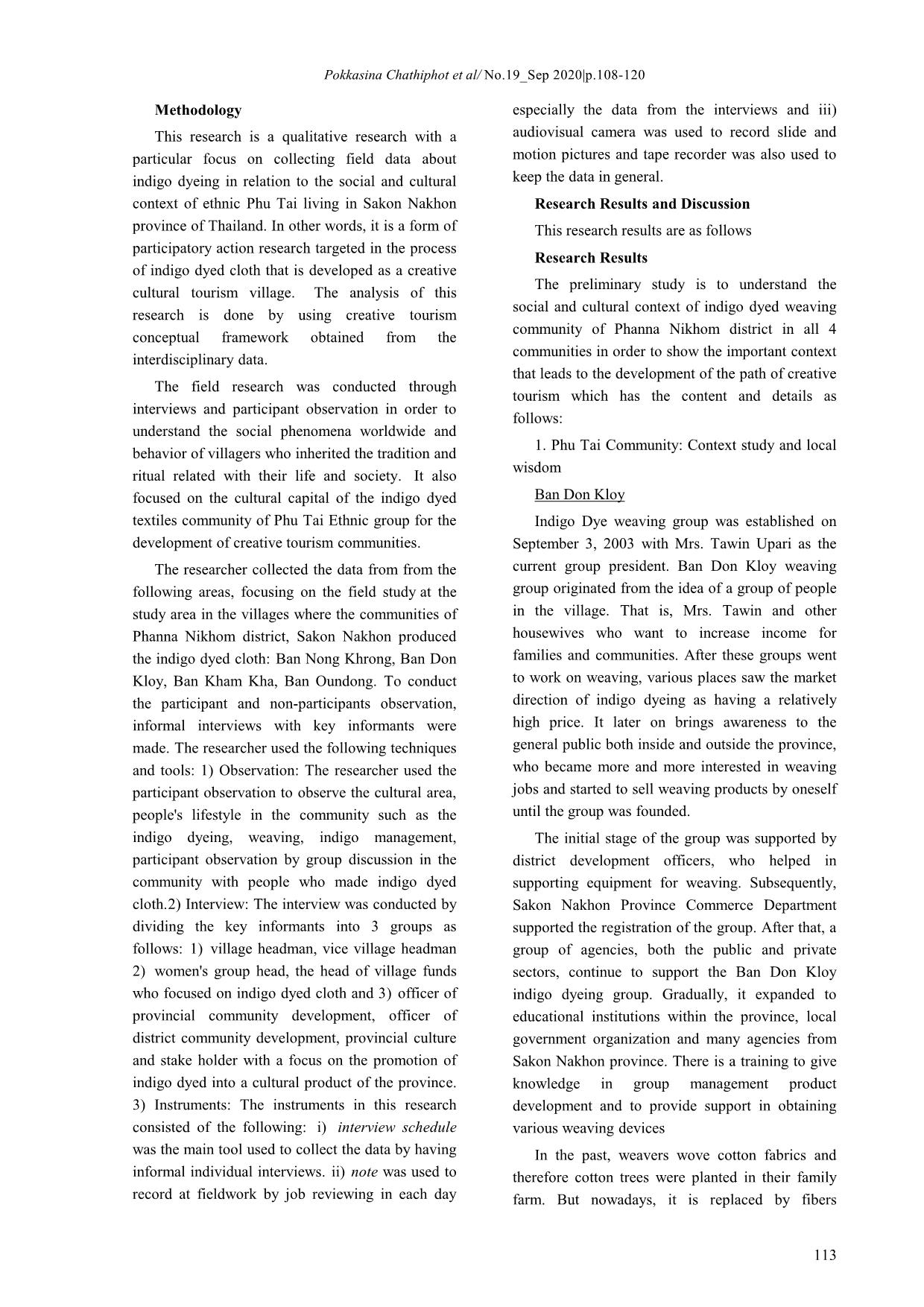
Trang 4
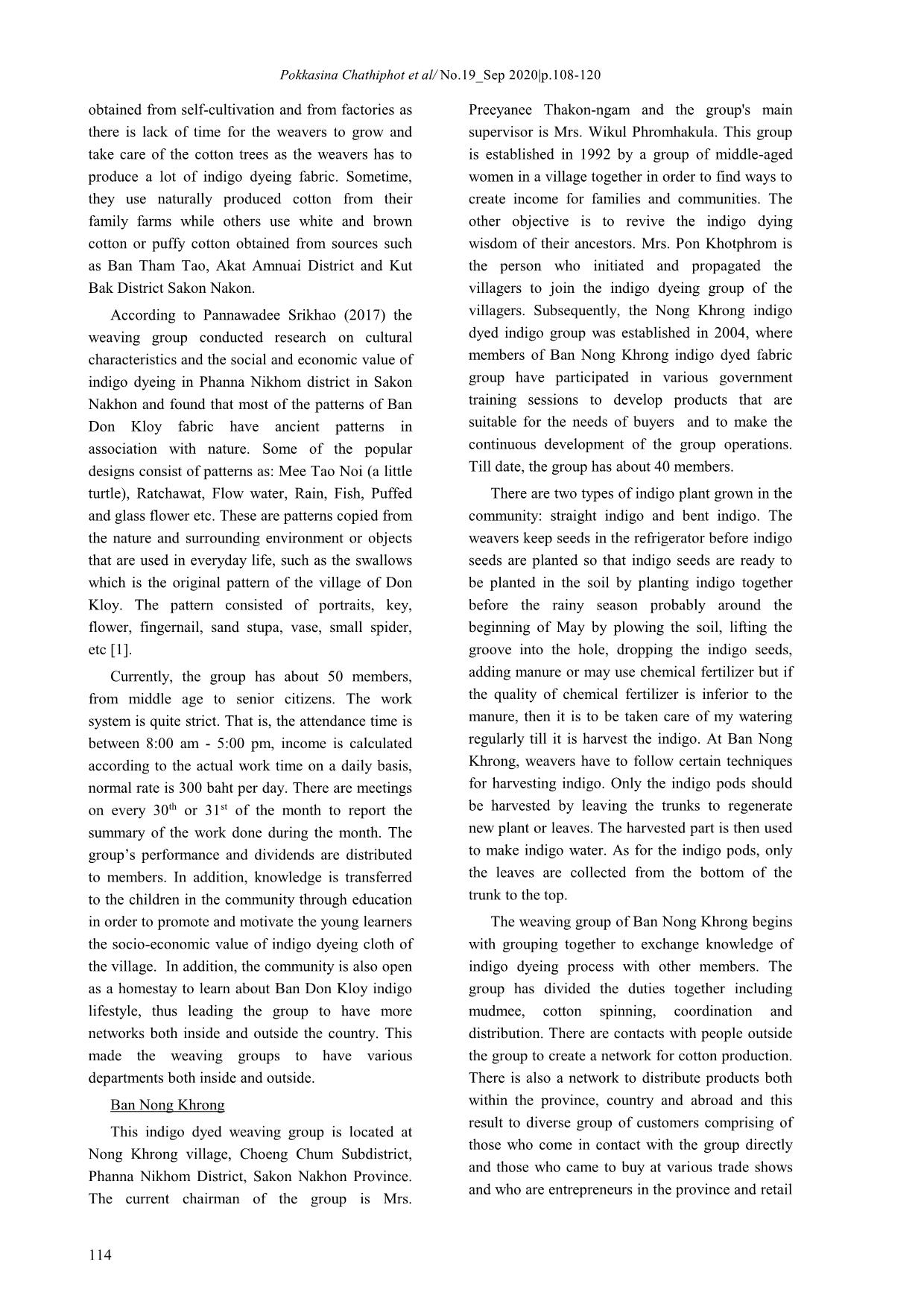
Trang 5
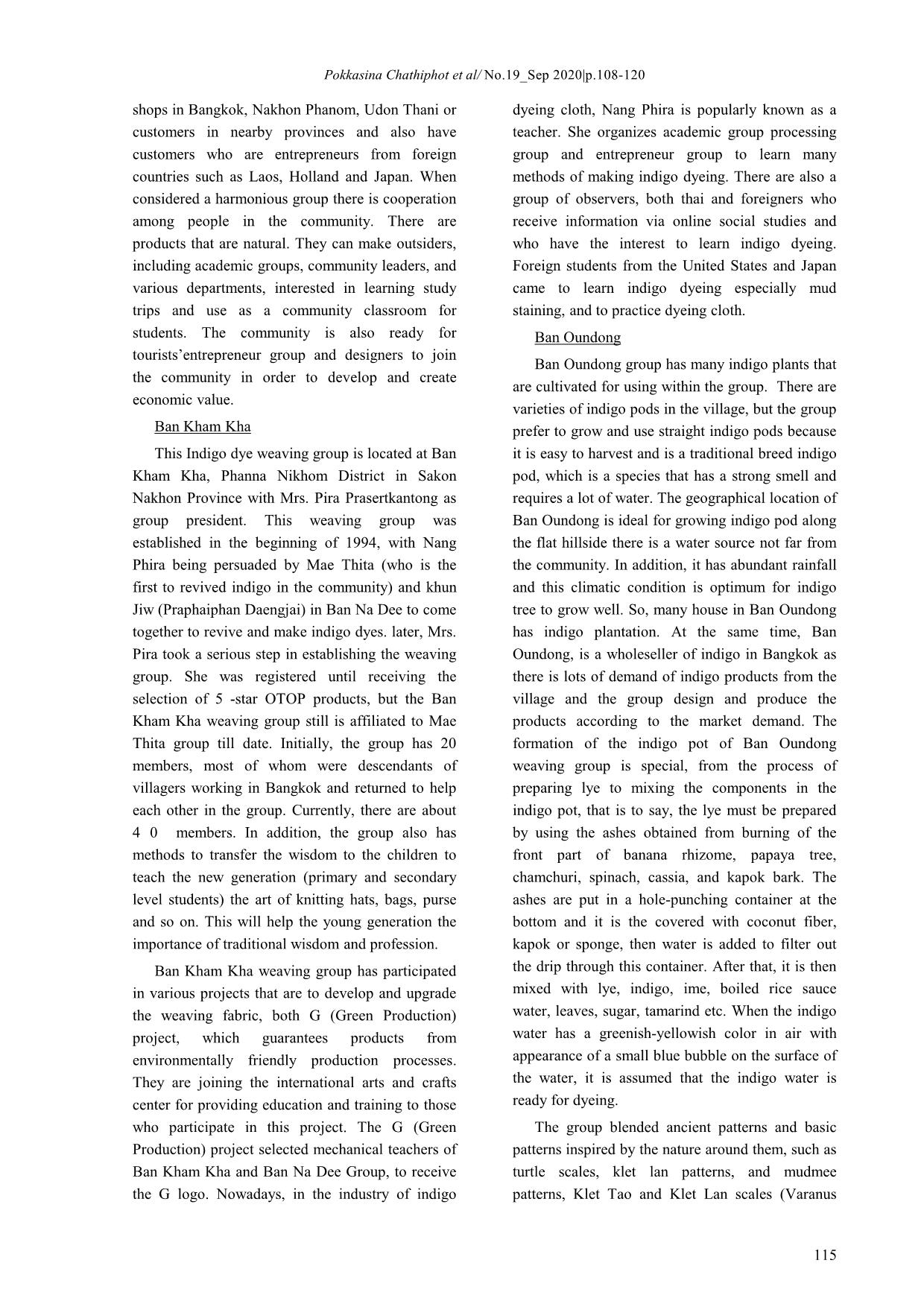
Trang 6
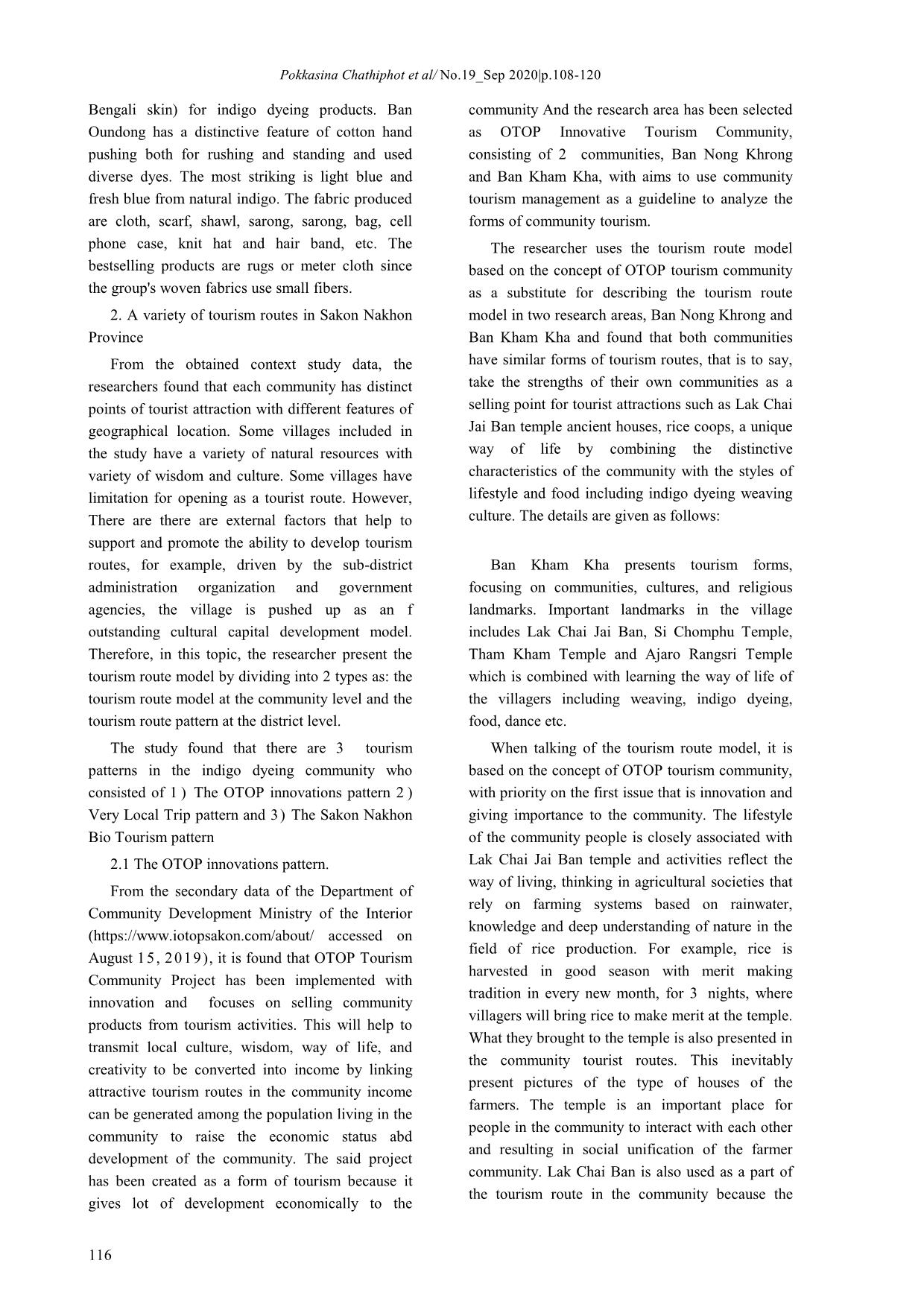
Trang 7
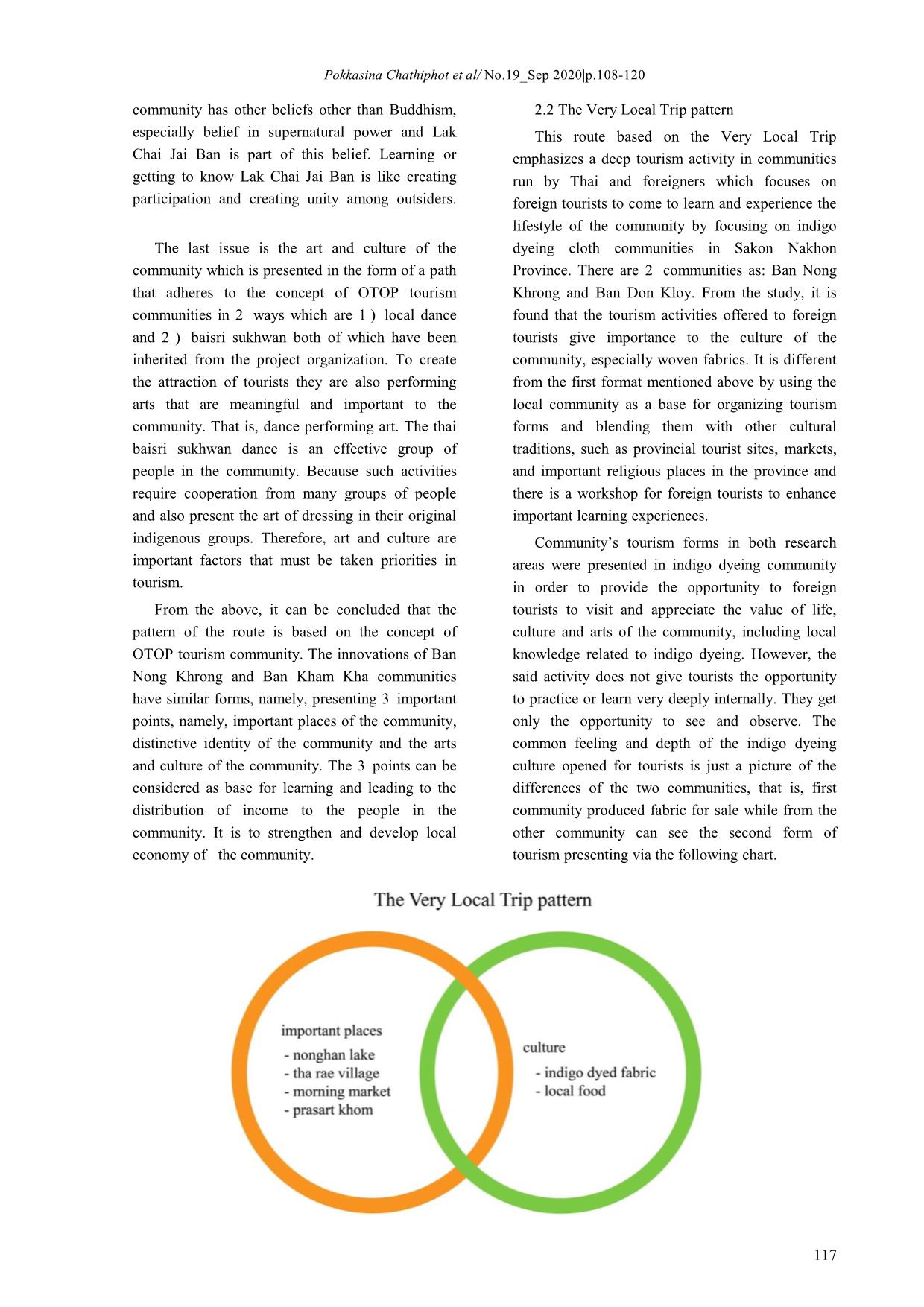
Trang 8
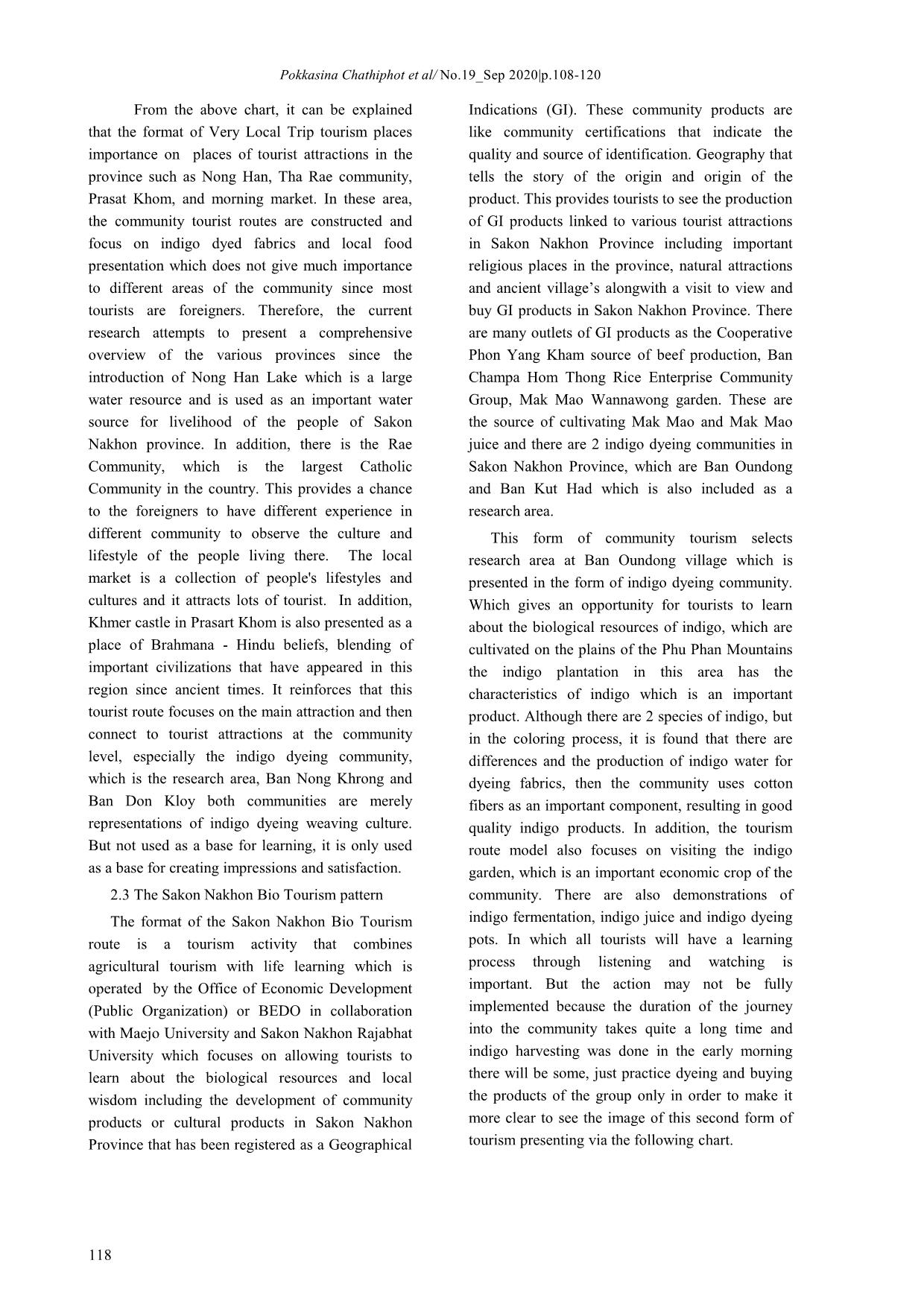
Trang 9
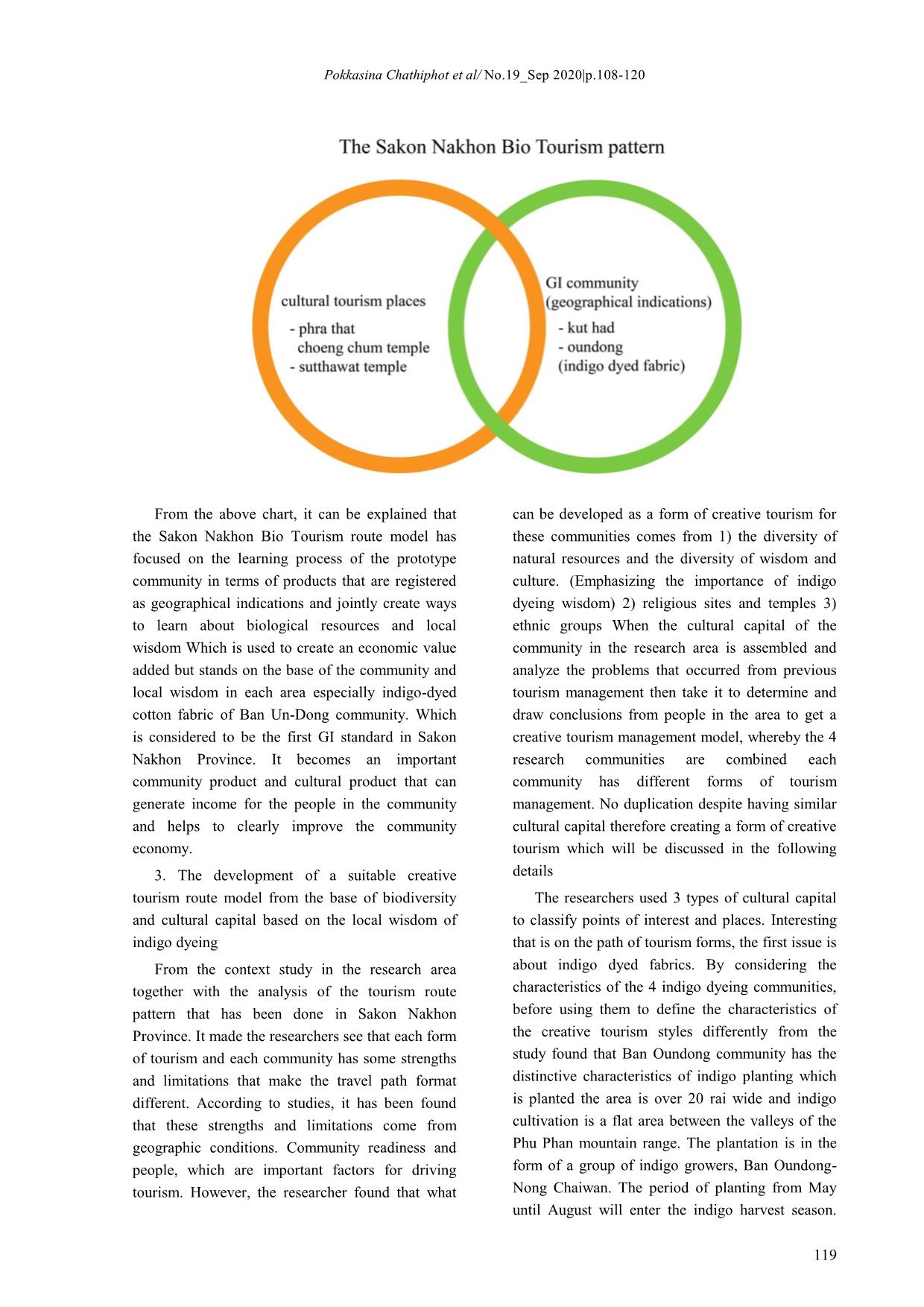
Trang 10
Tải về để xem bản đầy đủ
Tóm tắt nội dung tài liệu: The cultural capital of the indigo-dyed textiles community of Phu Tai ethnic group for the development of creative tourism communities
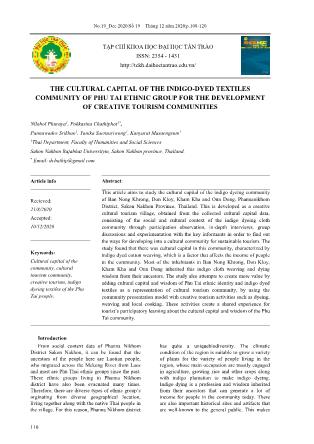
Community Group, Mak Mao Wannawong garden. These are the source of cultivating Mak Mao and Mak Mao juice and there are 2 indigo dyeing communities in Sakon Nakhon Province, which are Ban Oundong and Ban Kut Had which is also included as a research area. This form of community tourism selects research area at Ban Oundong village which is presented in the form of indigo dyeing community. Which gives an opportunity for tourists to learn about the biological resources of indigo, which are cultivated on the plains of the Phu Phan Mountains the indigo plantation in this area has the characteristics of indigo which is an important product. Although there are 2 species of indigo, but in the coloring process, it is found that there are differences and the production of indigo water for dyeing fabrics, then the community uses cotton fibers as an important component, resulting in good quality indigo products. In addition, the tourism route model also focuses on visiting the indigo garden, which is an important economic crop of the community. There are also demonstrations of indigo fermentation, indigo juice and indigo dyeing pots. In which all tourists will have a learning process through listening and watching is important. But the action may not be fully implemented because the duration of the journey into the community takes quite a long time and indigo harvesting was done in the early morning there will be some, just practice dyeing and buying the products of the group only in order to make it more clear to see the image of this second form of tourism presenting via the following chart. Pokkasina Chathiphot et al/ No.19_Sep 2020|p.108-120 119 From the above chart, it can be explained that the Sakon Nakhon Bio Tourism route model has focused on the learning process of the prototype community in terms of products that are registered as geographical indications and jointly create ways to learn about biological resources and local wisdom Which is used to create an economic value added but stands on the base of the community and local wisdom in each area especially indigo-dyed cotton fabric of Ban Un-Dong community. Which is considered to be the first GI standard in Sakon Nakhon Province. It becomes an important community product and cultural product that can generate income for the people in the community and helps to clearly improve the community economy. 3. The development of a suitable creative tourism route model from the base of biodiversity and cultural capital based on the local wisdom of indigo dyeing From the context study in the research area together with the analysis of the tourism route pattern that has been done in Sakon Nakhon Province. It made the researchers see that each form of tourism and each community has some strengths and limitations that make the travel path format different. According to studies, it has been found that these strengths and limitations come from geographic conditions. Community readiness and people, which are important factors for driving tourism. However, the researcher found that what can be developed as a form of creative tourism for these communities comes from 1) the diversity of natural resources and the diversity of wisdom and culture. (Emphasizing the importance of indigo dyeing wisdom) 2) religious sites and temples 3) ethnic groups When the cultural capital of the community in the research area is assembled and analyze the problems that occurred from previous tourism management then take it to determine and draw conclusions from people in the area to get a creative tourism management model, whereby the 4 research communities are combined each community has different forms of tourism management. No duplication despite having similar cultural capital therefore creating a form of creative tourism which will be discussed in the following details The researchers used 3 types of cultural capital to classify points of interest and places. Interesting that is on the path of tourism forms, the first issue is about indigo dyed fabrics. By considering the characteristics of the 4 indigo dyeing communities, before using them to define the characteristics of the creative tourism styles differently from the study found that Ban Oundong community has the distinctive characteristics of indigo planting which is planted the area is over 20 rai wide and indigo cultivation is a flat area between the valleys of the Phu Phan mountain range. The plantation is in the form of a group of indigo growers, Ban Oundong- Nong Chaiwan. The period of planting from May until August will enter the indigo harvest season. Pokkasina Chathiphot et al/ No.19_Sep 2020|p.108-120 120 Therefore consider that during the month of August onwards is the season of tourism in Ban Oundong community and tourists will be able to study and learn about indigo, a kind of natural color plant that has an influence on communities in terms of intellectual, cultural and economic value. It is a learning of important biological resources in the area of the community that can be applied to create a creative economy. Ban Kham Kha Community there are characteristics of knowledge related to the pot forming process. Preparing the dye who is complex process and has a unique style. It requires skills and experience in order to make the dye preparation effective and able to dye indigo with beautiful colors and including keeping the indigo pot to endure. The researcher has applied the knowledge of wisdom teachers as a guideline in determining the creative tourism model of Ban Kham Kha community. The second point is Religious places and temples linked to the form of tourism routes the researcher selects temples or religious sites that are located in the path of the community. The research area can be developed in conjunction with the creative tourism route. By establishing that it is an important point for tourists to study and learn about the history and autobiography of monks, professors and important people in relation to the temple or religious place resulting in temples or religious places appears on the tourist route, including Narai Jengweng Castle, Phra That Choeng Chum Stupa, Sutthawat Temple, Phurithat Thirawat Temple, Udom Somphon Temple and Santi Sangkharam temple which the form of tourism routes that have included the temples and religious sites of the city and Phanna Nikhom comprehensive and also composing a biography of the important monk of Sakon Nakhon Province, such as Luang Pu Man Phuritatthera, Luang Pu Fan Ajaro and Luang Pu Sim Phutthajaro, in which the religious matter will try present an overview of the practices and the simplicity of the life of the vipassana including temples that are the destination for those who want tranquility and religious learning resources. The last point is ethnic group., According to this research, the path of creative tourism found that the Phu Tai ethnic group is the main ethnic group and is a group that has a way of life, culture, associated with indigo dyeing cloth. It is the first group to revive the knowledge of indigo dyeing cloth to come back to life again and is a group that has inherited systematically creating that wisdom from one generation to another. Phu Tai people have a weaving culture that is closely tied to the system of relations of the family. There is a wide transfer of knowledge. In a contextual study, it was found that the Thai people of Ban Oundong have a close relationship with the Phu Tai people, Ban Kham Kha, Ban Nong Phai, Ban Non Ruea, Ban Tor Ruea, and Phu Tai people in Phanna Nikhom district. It is a group of people who migrated from Laos during the reign of King Rama III and were a group that came from Mueang Wang, Mueang Pin, Mueang Nong especially the Mueang Wang group that came to settle in Phanna Nikhom district and were scattered to settle in various areas making Phanna Nikhom District as one of the provinces in Sakon Nakhon Province that has a large number of Phu Tai people. In addition to getting to know more of the Phu Tai ethnic group, the research focuses to learn about other ways of life, culture of the Phu Tai people as well, such as the dress, food and language of the Phu Tai people as well. Discussion The title of the research "The Development of Creative Tourism Route Model from biodiversity and cultural capital based on the local wisdom of indigo dyeing community Sakon Nakhon" a new tourism approach that focuses on increasing experience and knowledge based on the concepts adopted from previous research (Wurzburger et al., 2009). This creative tourism concept focuses on developing and creating a network of creative cities and the knowledge promoting forum and understanding of culture and identity of each community through experience. This research suggests that the strengths of the culture and cultural identity of the community are used to create new experiences for tourists. It highlights the distinctive identity of the indigo dyeing community of Sakon Nakhon province as the core of creative tourism management and is compiled with historical sites, religious places and temples including the identity of ethnic groups to present to make a difference from traditional cultural tourism. In addition, in terms of types and behavior of tourists and cultural-related tourist sites, the Pokkasina Chathiphot et al/ No.19_Sep 2020|p.108-120 121 research suggests that creative tourists should be to engage in activities such as photography, painting, pottery making, food and handicraft work especially participation in learning about handicrafts from indigo dyeing works of the community. This includes to having knowledge learnt from wisdom teachers who are engaged in indigo making and indigo dyeing. This is in line with the tourists' behavior of Smith (2003) that each type of tourists are interested in different places and tourism activities which can be used as a guideline in formulating strategies to meet the needs which will lead to revenue generation for tourist destinations while promoting knowledge, understanding and preserving the culture of the community. Conclusion This research study is one of the important strategies of Sakon Nakhon province on trade investment and tourism by having a tourism policy of 3 cities that is composed of nature, dharma and culture together. This can be an aid to attract a variety of tourists, thus leading to develop into a concrete creative tourism. In addition, Sakon Nakhon Province is under the group of the upper northeast region 2 which has the potential to drive the economy resulting from creative tourism because there are a variety of natural attractions, biological resources and local knowledge including ethnic groups with unique identities and is also a bridge on the eastern economic corridor connecting to ASEAN countries and southern China. Therefore, it is necessary to plan for development of the region as a secondary city for tourist destination. Suggestions and Recommendations This study should extend 1. The study of the factors that affect the accomplishment of creative tourism in the weaving community, 2. The factors that contributed to the strengthening of weaving community, 3. Research results should be extended to other groups in the community employing the community empowerment approach from case study of indigo dyed cloth. References 1. Chathiphot, P. (2017). The role of Phu Tai women through their local wisdom of indigo-dyed textile in community strengthening in Sakon Nakhon province, Thailand. International Symposium on Social Sciences and Management. January 19-21, 2017. Hokkaido, Japan. pp. 315-328. 2. Pongsan Srisomsap. (2016). Creative Tourism Model for ASEAN Economi Community (AEC) : A case study of Chon Bun Province. Faculty of Political Science, Ramkhamhaeng University. 3. Chiranut Sopha et al. (2015). The Development of Gastronomic Tourism Routes in ASEAN. Suan Dusit Rajabhat University. 4. Chathiphot, D. (2015). Women’s life of weaving and indigo dyeing: Transmission and Creative wisdom of Phu Tai Indigo Dye Textile. The 5th Cultural Research: Culture in Life and Life in Culture: 5 July 2015. Bangkok: Department of Cultural Promotion, pp. 6-20. 5. Viboon Leesuwan. (1984). Folk crafts. Bangkok: Banya.2007). Encyclopedia of fabrics and weaving machines. Bangkok: Muang Boran. 6. Richards, G. (2011). Creativity and tourism: The state of the art. Annals of Tourism Research 38, 4, p.1225-1253. 7.Department of Intellectual Property. (2015). Announcement of the Department of Intellectual Property: Registration of Geographical indication Natural indigo fabric, Sakon Nakhon. 11 March 2015. Pokkasina Chathiphot et al/ No.19_Sep 2020|p.108-120 122 VỐN VĂN HÓA CỦA CỘNG ĐỒNG DÂN TỘC DỆT - NHUỘM CHÀM PHU TAI PHÁT TRIỂN SÁNG TẠO DU LỊCH CỘNG ĐỒNG Nilobol Phuraya, Pokkasina Chathiphot, Pannawadee Srikhao, Yanika Saensuriwong, Kanyarat Masaengsom Thông tin bài viết Tóm tắt Ngày nhận bài: 21/9/2020 Ngày duyệt đăng: 10/12/2020 Bài viết này nhằm mục đích nghiên cứu vốn văn hóa của cộng đồng nhuộm chàm Ban Nong Khrong, Don Kloy, Kham Kha và Oun Dong, huyện Phannanikhom, tỉnh Sakon Nakhon, Thái Lan. Đây được phát triển như một làng du lịch văn hóa sáng tạo, thu được từ dữ liệu vốn văn hóa thu thập được, bao gồm bối cảnh xã hội và văn hóa của cộng đồng nhuộm chàm thông qua quan sát tham gia, phỏng vấn sâu, thảo luận nhóm và thử nghiệm với những người cung cấp thông tin chính theo thứ tự để tìm ra cách phát triển thành một cộng đồng văn hóa cho du lịch bền vững. Nghiên cứu phát hiện ra rằng cộng đồng này có vốn văn hóa, đặc trưng là nghề dệt vải bông nhuộm chàm, đây là yếu tố ảnh hưởng đến thu nhập của người dân trong cộng đồng. Hầu hết các cư dân ở Ban Nong Khrong, Don Kloy, Kham Kha và Oun Dong đều thừa hưởng nghề dệt vải chàm và trí tuệ hấp hối này từ tổ tiên của họ. Nghiên cứu cũng cố gắng tạo ra nhiều giá trị hơn bằng cách bổ sung vốn văn hóa và trí tuệ của bản sắc dân tộc Phú Tài và dệt nhuộm chàm như một đại diện của cộng đồng du lịch văn hóa, bằng cách sử dụng mô hình trình bày cộng đồng với các hoạt động du lịch sáng tạo như nhuộm, dệt, địa nấu nướng. Các hoạt động này tạo ra một trải nghiệm chung để khách du lịch có thể tham gia học hỏi về vốn văn hóa và trí tuệ của cộng đồng Phú Tài. Từ khóa: Vốn văn hóa cộng đồng, văn hóa du lịch cộng đồng, du lịch sáng tạo, dệt nhuộm chàm của người Phú Tài.
File đính kèm:
 the_cultural_capital_of_the_indigo_dyed_textiles_community_o.pdf
the_cultural_capital_of_the_indigo_dyed_textiles_community_o.pdf

